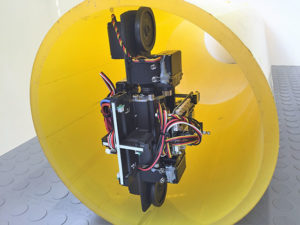Mapping Pipeline Infrastructure with PipeRider Platform Technology
 The versatile PipeRider technology can enable safer, faster, and more efficient pipeline inspection at lower cost, using cameras for visual inspection and anomaly detection.
The versatile PipeRider technology can enable safer, faster, and more efficient pipeline inspection at lower cost, using cameras for visual inspection and anomaly detection.
There are about 2.6 million miles of natural gas pipeline in the U.S., often located in high consequence areas under older cities like Boston, where access for inspection is challenging.
In-Line Inspection (ILI) pipe crawlers are a common technology used for many years by utilities to inspect gas pipelines. They are usually tethered and have large, heavy arrays of contact-type corrosion sensors, cameras, and motors with multiple tires.
The new PipeRider takes a radically different approach to ILI. It only has two tires and is battery operated. The tethered model sends real-time video or mapping data back to its remote operator, and an optional untethered version travels autonomously and records this same data for later retrieval. Its travel range is only limited by the distance between charging stations, and it could potentially live inside the pipe, inspecting and mapping everything between charging /data retrieval stations within a defined diameter range.
PipeRider is smaller and lighter than other pipe crawlers, and can be launched using keyhole excavations. Once inside a gas pipeline system, It has a corrosion assessment and leak detection payload, so the built-in mapping capabilities can augment a digital twin model of a natural gas pipeline.
“We have watched technology get smaller and more amazing over the last 15 years, and pipeline operators have long awaited in-line inspection (ILI) technology to do the same,” said Jim Louis, Associate Engineer, Energy Delivery & Utilization. “GTI Energy will partner with academia and the government to push the limits of how small we can make a fully functional autonomous mobile robot (AMR) platform to access 4-to-6-inch diameter lines.”
Learn More
Contact the energy experts today
